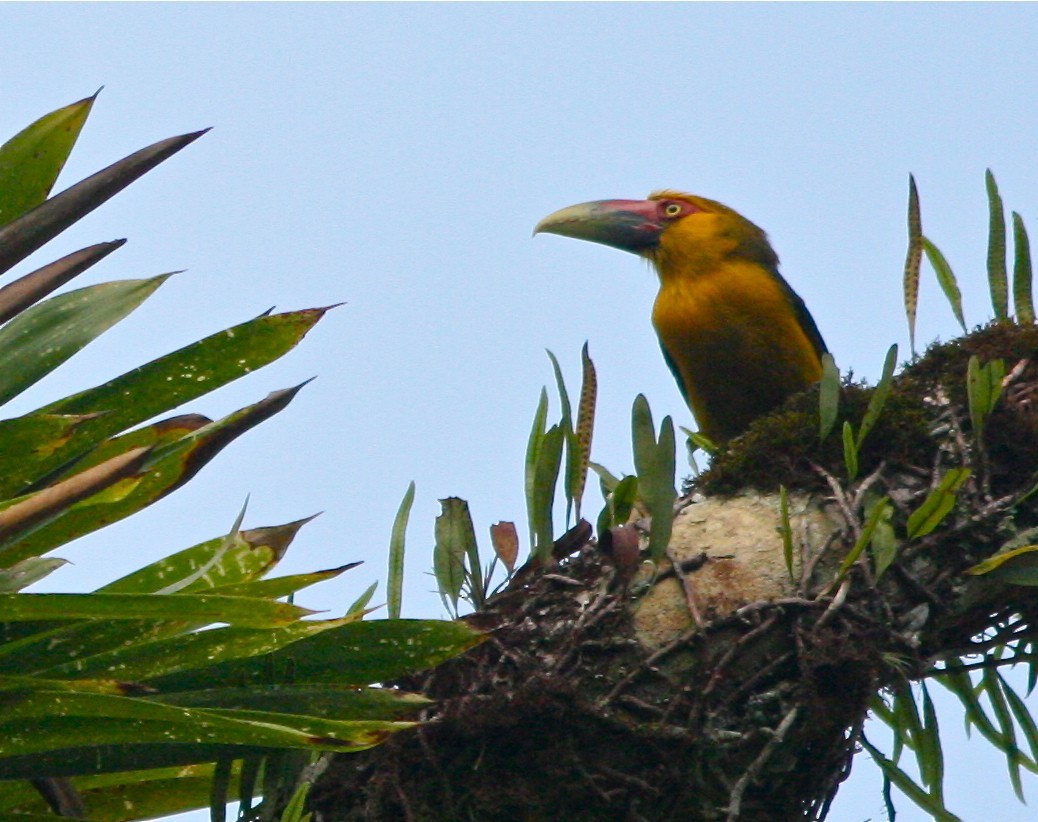Saffron Toucanet
A species of Baillonius Scientific name : Pteroglossus bailloni Genus : Baillonius
Saffron Toucanet, A species of Baillonius
Botanical name: Pteroglossus bailloni
Genus: Baillonius
Content
Description General Info
 Photo By Don Roberson
Photo By Don Roberson Description
It is a relatively long-tailed toucan with a total length of 35–40 cm (14–16 in). As suggested by its common name, it is, uniquely among toucans, overall saffron yellow. The back and tail are darker, more olive in color. The rump, ocular skin and patches on the basal half of the otherwise greenish-horn bill are red. The iris is pale yellowish. This species is dimorphic, meaning that males and females have distinguished looks from each other. The adult male has a golden head and breast, olive mantle (the wings, shoulder feathers and back) and red rump. They have a modestly sized bill, with green, grey blue, and yellowish-grey color all along it. Adult females are similar to the male but have more olive and less gold coloration; they also have a shorter bill. A young toucanet is mostly olive and grey colored, with brown eyes and a blotchy bill. 
Size
39 cm
Nest Placement
Cavity
Feeding Habits
Saffron Toucanet's diet mainly includes fruits such as figs and palm fruits, and occasionally young birds. Saffron Toucanet exhibits expedient foraging, capable of raiding nests swiftly due to its smaller body, enabling quick entry and exit. This species has adapted to opportunistic feeding, including attempted predation on woodpecker nests.
Dite type
Frugivorous
General Info
Feeding Habits
Bird food type

Fruit
Behavior
The saffron is a large-gape frugivore. Due to their nature, they are especially crucial for plants with larger seeds to disperse themselves to further areas. They are one of the few birds that are capable of carrying larger seeds to new locations. One study suggests that there is a strong association between species’ contribution to network modularity and species’ number of interactions. Species with many links tend to establish interactions both within and among environments and to exhibit a greater contribution to nestedness. On average, species that contribute more to network organization, like the saffron, are at a higher risk of extinction. Without a connection between certain species of plant, there may be ecological and evolutionary consequences such as co-extinction. 
Distribution Area
The saffron is found in the Atlantic Forest. The viridis group, a superspecies group that includes the saffron, was separated from the other Pteroglossus group around 3 million years ago. The topologies observed in the study showed the saffron toucanet as a member of the Pteroglossus viridis group instead of a sister lineage to all other Pteroglossus. The saffron is separated from the other species in the viridis group by the Brazilian savanna biome. It is thought that this species is part of an ancient stock that became isolated in the current Atlantic Forest from marine transgression and were not able to adapt and invade the Brazilian savanna. It depends on forested habitats to survive. One study investigated whether species endemic to the Atlantic forest and with small geographic ranges were more vulnerable to forest fragmentation. This species was found to be “endemic and high sensitivity” to the fragmentation, meaning that since they are native to the land, they are more likely to be affected by the split. It was found that species at the edges of their ranges were sensitive to fragmentation as well. This may be due to fewer nearby populations for species to move to once their local populations were lost. 
Species Status
It is threatened by habitat loss, degradation, hunting, and being captured. They are currently considered Near Threatened by BirdLife International. It occurs in several protected areas, such as the Itatiaia National Park and Intervales State Park; both in south-eastern Brazil. 

 Photo By Don Roberson
Photo By Don Roberson